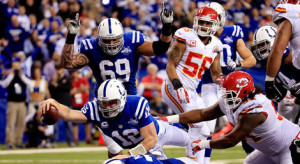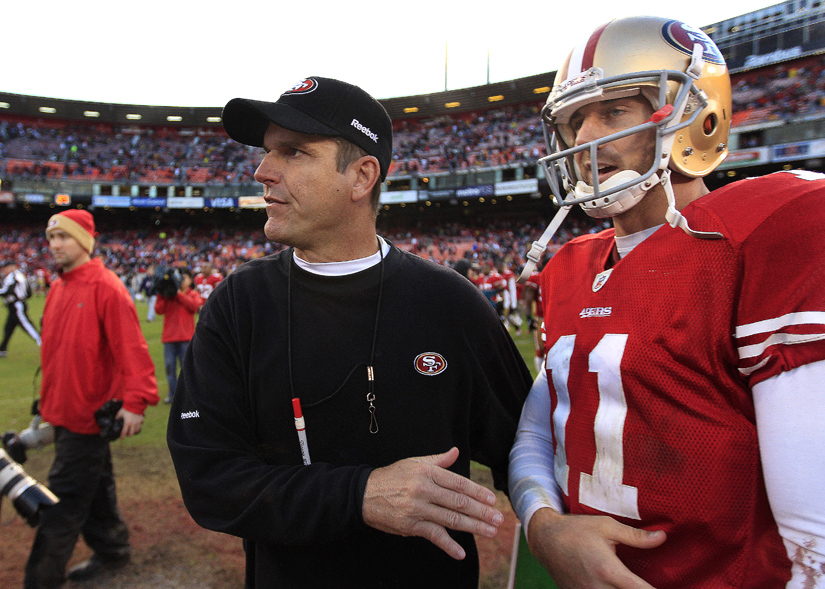How rare is it for a quarterback to throw a touchdown pass to a player, and then throw a touchdown pass 12 years later to the same player on a new team? Well, it’s never happened before. The closest was with Randall Cunningham and Cris Carter; the duo connected for a touchdown pass in November 1987 with the Eagles, and last connected for a touchdown pass in September 1999 with the Vikings, a span of nearly 12 years.
The table below shows, through 2017, all QB/Receiver pairings where the duo connected for touchdown passes on different teams. I have used “different teams” liberally here (e.g., including the old Browns and Ravens as different teams), but you can consider them the same team if you like.
| QB | Receiver | First TD | First Tm | Last TD | Last Tm | TD Tm1 | TD Tm2 | Total TDs | Years |
|---|---|---|---|---|---|---|---|---|---|
| Alex Smith | Vernon Davis | 09/10/2006 | sfo | 10/14/2018 | was | 35 | 1 | 36 | 12.1 |
| Randall Cunningham | Cris Carter | 11/01/1987 | phi | 09/12/1999 | min | 17 | 16 | 33 | 11.9 |
| Y.A. Tittle | Hugh McElhenny | 10/05/1952 | sfo | 10/27/1963 | nyg | 13 | 2 | 15 | 11.1 |
| Drew Bledsoe | Terry Glenn | 09/08/1996 | nwe | 10/01/2006 | dal | 21 | 10 | 31 | 10.1 |
| Peyton Manning | Brandon Stokley | 12/14/2003 | clt | 01/12/2013 | den | 18 | 6 | 24 | 9.1 |
| Jay Schroeder | Gary Clark | 12/08/1985 | was | 12/04/1994 | crd | 14 | 1 | 15 | 9 |
| Steve McNair | Derrick Mason | 10/25/1998 | oti | 09/23/2007 | rav | 30 | 3 | 33 | 8.9 |
| George Blanda | Billy Cannon | 10/30/1960 | oti | 11/24/1968 | rai | 20 | 1 | 21 | 8.1 |
| Jay Cutler | Eddie Royal | 09/08/2008 | den | 09/11/2016 | chi | 5 | 2 | 7 | 8 |
| Jay Cutler | Brandon Marshall | 12/03/2006 | den | 11/16/2014 | chi | 14 | 26 | 40 | 8 |
| Ken Stabler | Dave Casper | 09/22/1974 | rai | 11/29/1981 | oti | 38 | 7 | 45 | 7.2 |
| Zeke Bratkowski | Carroll Dale | 09/17/1961 | ram | 10/20/1968 | gnb | 4 | 7 | 11 | 7.1 |
| Brian Griese | Desmond Clark | 09/04/2000 | den | 10/07/2007 | chi | 7 | 2 | 9 | 7.1 |
| Vinny Testaverde | Mark Carrier | 12/06/1987 | tam | 01/01/1995 | cle | 21 | 5 | 26 | 7.1 |
| Jim Harbaugh | Curtis Conway | 10/10/1993 | chi | 11/05/2000 | sdg | 2 | 2 | 4 | 7.1 |
| Carson Palmer | T.J. Houshmandzadeh | 11/28/2004 | cin | 12/04/2011 | rai | 34 | 1 | 35 | 7 |
| Fran Tarkenton | Bob Tucker | 10/25/1970 | nyg | 10/30/1977 | min | 8 | 1 | 9 | 7 |
| Neil O'Donnell | Yancey Thigpen | 09/19/1993 | pit | 09/10/2000 | oti | 11 | 4 | 15 | 7 |
| Vinny Testaverde | Keyshawn Johnson | 09/20/1998 | nyj | 12/19/2004 | dal | 8 | 6 | 14 | 6.2 |
| Carson Palmer | Jermaine Gresham | 09/12/2010 | cin | 11/27/2016 | crd | 4 | 3 | 7 | 6.2 |
| Jack Kemp | Keith Lincoln | 11/12/1961 | sdg | 12/09/1967 | buf | 1 | 5 | 6 | 6.1 |
| Trent Dilfer | Darrell Jackson | 11/04/2001 | sea | 10/21/2007 | sfo | 5 | 1 | 6 | 6 |
| Billy Wade | Joe Marconi | 09/26/1959 | ram | 10/25/1964 | chi | 1 | 4 | 5 | 5.1 |
| Steve DeBerg | Tony Martin | 12/05/1993 | mia | 12/27/1998 | atl | 1 | 1 | 2 | 5.1 |
| Neil O'Donnell | Jeff Graham | 09/06/1992 | pit | 08/31/1997 | nyj | 1 | 3 | 4 | 5 |
| Jim Harbaugh | Floyd Turner | 09/04/1994 | clt | 12/13/1998 | rav | 10 | 5 | 15 | 4.3 |
| Jim Harbaugh | Roosevelt Potts | 09/25/1994 | clt | 12/27/1998 | rav | 2 | 2 | 4 | 4.3 |
| Browning Nagle | Terance Mathis | 10/04/1992 | nyj | 12/02/1996 | atl | 2 | 1 | 3 | 4.2 |
| Earl Morrall | Norm Bulaich | 10/10/1971 | clt | 12/01/1975 | mia | 2 | 1 | 3 | 4.1 |
| Jim Hardy | Bob Shaw | 10/20/1946 | ram | 12/10/1950 | crd | 1 | 11 | 12 | 4.1 |
| Ralph Guglielmi | Joe Walton | 11/02/1958 | was | 12/09/1962 | nyg | 5 | 1 | 6 | 4.1 |
| Vinny Testaverde | Michael Jackson | 10/24/1993 | cle | 11/16/1997 | rav | 12 | 17 | 29 | 4.1 |
| Ernie Nevers | Cobb Rooney | 10/10/1926 | dul | 10/26/1930 | crd | 2 | 3 | 5 | 4 |
| Josh McCown | Matt Forte | 11/17/2013 | chi | 12/03/2017 | nyj | 2 | 1 | 3 | 4 |
| Lamar McHan | Gary Knafelc | 10/04/1959 | gnb | 10/20/1963 | sfo | 2 | 1 | 3 | 4 |
| Vinny Testaverde | Brian Kinchen | 09/26/1993 | cle | 10/05/1997 | rav | 3 | 2 | 5 | 4 |
| Tarvaris Jackson | Sidney Rice | 11/25/2007 | min | 11/20/2011 | sea | 7 | 2 | 9 | 4 |
| Peyton Manning | Jacob Tamme | 11/01/2010 | clt | 09/21/2014 | den | 4 | 6 | 10 | 3.9 |
| Frank Reich | Pete Metzelaars | 12/15/1991 | buf | 09/03/1995 | car | 2 | 1 | 3 | 3.7 |
| Rodney Peete | Irving Fryar | 09/01/1996 | phi | 01/02/2000 | was | 3 | 1 | 4 | 3.3 |
| Chuck Muncie | Wes Chandler | 09/02/1979 | nor | 12/20/1982 | sdg | 1 | 2 | 3 | 3.3 |
| George Taliaferro | Dick Wilkins | 09/02/1949 | lda | 11/27/1952 | dtx | 2 | 1 | 3 | 3.2 |
| Boomer Esiason | Rob Moore | 09/05/1993 | nyj | 11/17/1996 | crd | 6 | 1 | 7 | 3.2 |
| Vinny Testaverde | Derrick Alexander | 09/18/1994 | cle | 11/02/1997 | rav | 2 | 16 | 18 | 3.1 |
| Milt Plum | Tom Watkins | 09/24/1961 | cle | 11/01/1964 | det | 1 | 1 | 2 | 3.1 |
| Rich Gannon | Andre Rison | 11/30/1997 | kan | 12/16/2000 | rai | 5 | 6 | 11 | 3 |
| Bob Gagliano | Terry Greer | 10/11/1987 | sfo | 10/07/1990 | det | 1 | 1 | 2 | 3 |
| Kent Graham | LeShon Johnson | 09/29/1996 | crd | 09/26/1999 | nyg | 1 | 1 | 2 | 3 |
| James Harris | Bob Klein | 11/04/1974 | ram | 10/30/1977 | sdg | 5 | 1 | 6 | 3 |
| Josh McCown | Austin Seferian-Jenkins | 11/09/2014 | tam | 10/22/2017 | nyj | 1 | 3 | 4 | 3 |
| Rich Gannon | Derrick Walker | 11/28/1996 | kan | 10/10/1999 | rai | 1 | 1 | 2 | 2.9 |
| Gus Frerotte | Randy McMichael | 09/11/2005 | mia | 12/02/2007 | ram | 5 | 2 | 7 | 2.2 |
| Kyle Orton | Brandon Lloyd | 09/21/2008 | chi | 11/28/2010 | den | 2 | 9 | 11 | 2.2 |
| Erik Kramer | Chris Penn | 10/12/1997 | chi | 10/03/1999 | sdg | 5 | 1 | 6 | 2 |
| Norm Snead | Bob Grim | 10/31/1971 | min | 10/21/1973 | nyg | 1 | 3 | 4 | 2 |
| Benny Friedman | Len Sedbrook | 11/18/1928 | dwl | 10/05/1930 | nyg | 2 | 6 | 8 | 1.9 |
| Jeff Blake | Willie Jackson | 09/12/1999 | cin | 11/05/2000 | nor | 2 | 1 | 3 | 1.1 |
| Benny Friedman | Ossie Wiberg | 11/06/1927 | cib | 12/09/1928 | dwl | 2 | 2 | 4 | 1.1 |
| Benny Friedman | Rex Thomas | 10/30/1927 | cib | 11/29/1928 | dwl | 2 | 2 | 4 | 1.1 |
| Al Dekdebrun | Ray Ebli | 11/10/1946 | bba | 12/07/1947 | cra | 1 | 1 | 2 | 1.1 |
| Vinny Testaverde | Earnest Byner | 09/24/1995 | cle | 10/20/1996 | rav | 1 | 1 | 2 | 1.1 |
| Benny Friedman | Carl Bacchus | 10/23/1927 | cib | 11/11/1928 | dwl | 3 | 3 | 6 | 1.1 |
| Benny Friedman | Proc Randels | 11/27/1927 | cib | 12/09/1928 | dwl | 1 | 1 | 2 | 1 |
| Bob Celeri | Buddy Young | 10/21/1951 | nyy | 10/26/1952 | dtx | 2 | 1 | 3 | 1 |
| Bob Celeri | George Taliaferro | 12/09/1951 | nyy | 10/18/1952 | dtx | 2 | 1 | 3 | 0.9 |
Stabler and Casper hold the record for combined touchdowns on two teams, at 45, although most of those were in Oakland. Bledsoe/Glenn, Cunningham/Carter, Cutler/Marshall, and — if you want to include them, Testaverde/Jackson and Testaverde/Alexander — are the only pairs to connect for double digit touchdowns on two different teams.





